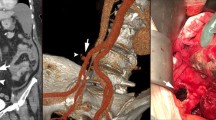Abstract
Tumor-bowel fistula is an under reported complication of abdomino-pelvic malignancies which may occur spontaneously due to tumor growth or can be associated with cancer treatment. Chemotherapy and radiotherapy are commonly responsible for tumor-bowel fistulas. Molecular targeted therapies are a new class of drugs that can cause tumor fistulization due to their antiangiogenic properties. Clinically, the fistula can be asymptomatic or can result in devastating complications. Imaging helps in the prompt detection of these fistulas and the complications associated with them. Management of tumor-bowel fistula is individualized but often involves discontinuation of the associated treatment. Radiologists should promptly alert the oncology team about the presence of tumor-bowel fistula and any risk factors for its occurrence like pneumatosis or large metastatic deposits close to bowel loops.










Similar content being viewed by others
References
Pickhardt PJ, Bhalla S, Balfe DM (2002) Acquired gastrointestinal fistulas: classification, etiologies, and imaging evaluation. Radiology 224:9–23
Falconi M, Pederzoli P (2001) The relevance of gastrointestinal fistulae in clinical practice: a review. Gut 49:iv2–iv10
Narayanan P, Nobbenhuis M, Reynolds KM, Sahdev A, et al. (2009) Fistulas in malignant gynecologic disease: etiology, imaging, and management. Radiographics 29:1073–1083
Bats AS, Rockall AG, Singh N, Reznek RH, Jeyarajah A (2010) Perforation of a malignant ovarian tumor into the recto-sigmoid colon. Acta Obstet Gynecol Scand 89:1362–1363
Kim SJ, Kimoto Y, Nakamura H, et al. (1999) Ovarian carcinoma with fistula formation to the sigmoid colon and ileum: report of a case. Surg Today 29:449–452
Yahagi N, Kobayashi Y, Ohara T, et al. (2011) Ovarian carcinoma complicated by sigmoid colon fistula formation: a case report and review of the literature. J Obstet Gynaecol Res 37:250–253
Mahajan SK, Sood BR, Vaidya P, Thakur S, Pal LS (2006) Malignant colo-jejunal fistula—a rare internal fistula. J Assoc Physicians India 54:336–337
Majeed TA, Gaurav A, Shilpa D, et al. (2011) Malignant coloduodenal fistulas—review of literature and case report. Indian J Surg Oncol 2:205–209
Chun HB, Baek IH, Lee MS, et al. (2011) Jejunocolic fistula associated with an intestinal T cell lymphoma. Gut Liver 5:387–390
Emmert C, Kohler U (1996) Management of genital fistulas in patients with cervical cancer. Arch Gynecol Obstet 259:19–24
Biewenga P, Mutsaerts MA, Stalpers LJ, et al. (2010) Can we predict vesicovaginal or rectovaginal fistula formation in patients with stage IVA cervical cancer? Int J Gynecol Cancer 20:471–475
Shinagare AB, Howard SA, Krajewski KM, et al. (2012) Pneumatosis intestinalis and bowel perforation associated with molecular targeted therapy: an emerging problem and the role of radiologists in its management. AJR Am J Roentgenol 199:1259–1265
Abu-Hejleh T, Mezhir JJ, Goodheart MJ, Halfdanarson TR (2012) Incidence and management of gastrointestinal perforation from bevacizumab in advanced cancers. Curr Oncol Rep 14:277–284
Badgwell B, Camp E, Feig B, et al. (2008) Management of bevacizumab-associated bowel perforation: a case series and review of the literature. Ann Oncol 19:577–582
Sliesoraitis S, Tawfik B (2011) Bevacizumab-induced bowel perforation. J Am Osteopath Assoc 111:437–441
Tol J, Cats A, Mol L, et al. (2008) Gastrointestinal ulceration as a possible side effect of bevacizumab which may herald perforation. Invest New Drugs 26:393–397
Faivre S, Delbaldo C, Vera K, et al. (2006) Safety, pharmacokinetic, and antitumor activity of SU11248, a novel oral multitarget tyrosine kinase inhibitor, in patients with cancer. J Clin Oncol 24:25–35
Curley SA, Marra P, Beaty K, et al. (2004) Early and late complications after radiofrequency ablation of malignant liver tumors in 608 patients. Ann Surg 239:450–458
Ong GY, Changchien CS, Lee CM, et al. (2004) Liver abscess complicating transcatheter arterial embolization: a rare but serious complication. A retrospective study after 3878 procedures. Eur J Gastroenterol Hepatol 16:737–742
Wang CY, Leung SW, Wang JH, Yu PC, Wang CC (2009) Delayed spontaneous hepatogastric fistula formation following transcatheter arterial embolisation and radiotherapy for hepatocellular carcinoma. Br J Radiol 82:e105–e107
Asmis TR, Chung KY, Teitcher JB, Kelsen DP, Shah MA (2008) Pneumatosis intestinalis: a variant of bevacizumab related perforation possibly associated with chemotherapy related GI toxicity. Invest New Drugs 26:95–96
Chow H, Jung A, Talbott J, et al. (2011) Tumor fistulization associated with targeted therapy: computed tomographic findings and clinical consequences. J Comput Assist Tomogr 35:86–90
Saif MW, Elfiky A, Salem RR (2007) Gastrointestinal perforation due to bevacizumab in colorectal cancer. Ann Surg Oncol 14:1860–1869
Hurwitz H, Fehrenbacher L, Novotny W, et al. (2004) Bevacizumab plus irinotecan, fluorouracil, and leucovorin for metastatic colorectal cancer. N Engl J Med 350:2335–2342
Author information
Authors and Affiliations
Corresponding author
Rights and permissions
About this article
Cite this article
Tirumani, S.H., Baez, J.C., Jagannathan, J.P. et al. Tumor-bowel fistula: what radiologists should know. Abdom Imaging 38, 1014–1023 (2013). https://doi.org/10.1007/s00261-013-9987-6
Published:
Issue Date:
DOI: https://doi.org/10.1007/s00261-013-9987-6




